The best way to understand Hurricane ISO’s place in the Saucony assortment is to look at it through a vertical and lateral lens. The $150 Hurricane is to the cheaper Guide 8 as what the Triumph ISO is to the Ride 7 – a more supportive version of the $120 Guide 8, in the same way the Triumph is supposed to be a more cushioned version of the Ride.
In short, the Triumph and Hurricane represent Saucony’s pinnacle offering for the neutral and stability/guidance category, respectively speaking.
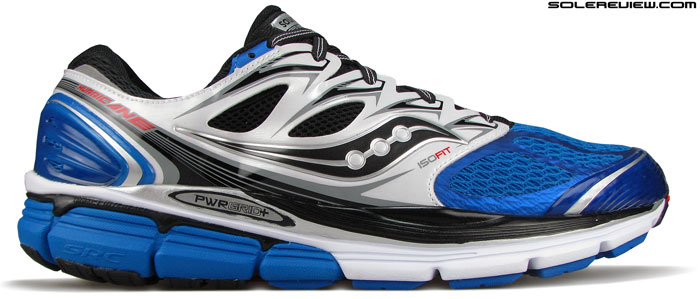
Built on the new ISOFIT upper platform, the Hurricane can also be interpreted as a ‘support’ version of the Triumph, in addition to being Guide 8’s big brother.
View the Hurricane from a sideways lens, and what you have is a more supportive avatar of the new Triumph ISO, a shoe with which the Hurricane shares a great deal of common parts and visual elements. If you’ve been in a Triumph ISO, the Hurricane is an easy read; take the Triumph ISO’s upper fit and feel (for the most part), mate it to a more stable platform, and there you are. At least, that’s the gist of it.
The Hurricane ISO is a good functional package; things which worked on the Triumph ISO does so here too, and given the Hurricane’s positioning, the ride quality fares rather well for itself. There are really no functional blemishes to speak of, though the scope for areas of improvements remain. However, there is one area which bothers us, and it will serve the review well to get it off our chest right at the start, and then focus on the good stuff.
If you’ve read our Triumph ISO review, you might have already guessed what we’re getting at. Yes, it is Saucony’s new ‘Powergrid+’ system. The Grid cushioning system has been around for a long time, but at the same time we have to recognise its drastic evolution, far removed from what it used to be once. Starting with an actual grid of Dupont Hytrel filaments acting as a trampoline – picture a tennis racket – the last version of the Powergrid (in the Guide 8/Ride 7) was a separate layer of perforated foam atop the midsole.
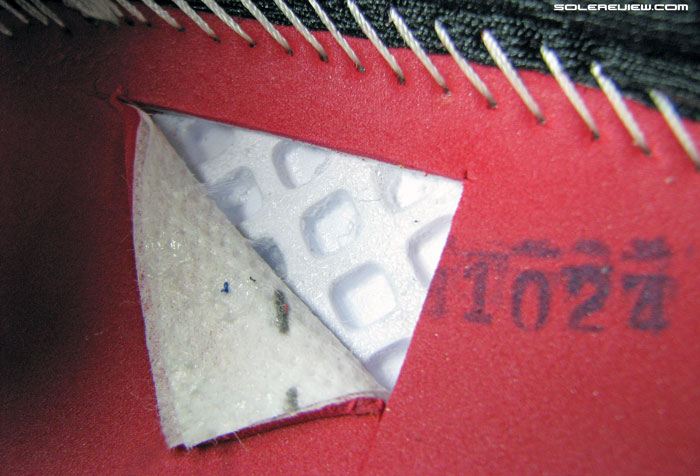
The new ‘Powergrid+’ in the Hurricane and Triumph is an eyewash. It makes do by just molding some depressions into the midsole foam, no separate layer as was the case before.
That design was replaced by the Powergrid+ on the new 2015 Triumph ISO. What it does is to remove the second layer of responsive foam, and simply stamp in a ‘grid’ design, or depressions in it. Saucony makes lofty claims like ‘20% more cushioning than standard midsoles’, but there’s little information on what benchmarks were referenced to back that statement.
Our point is, that the new Powergrid+ reeks of snake oil marketing – nothing special about the Powergrid+, just a manufacturing method designed to save money. Same way how Nike’s original Vectran fibre based Flywire eventually degraded into a few strands of cheap polyester threads.
Look past Powergrid+’s marketing follies, and there will be few areas for complaints; the upper feels and fits great, and there’s a good mix of support and cushioning between your foot and the road.
The new Hurricane is based on Saucony’s new ISO upper platform, a design which includes a soft inner sleeve working together with a floating synthetic cage on the outside. But not all is exactly the same across; there are variations in Hurricane’s ISOFIT design over the Triumph.
The interior environment is demarcated by three different materials; the slightly elastic ISOFIT sleeve around the midfoot, the unlined forefoot mesh to which the ISO sleeve is attached, and in the heel a soft, foam backed fabric which lines the collar area.
Heel construction is near identical to Triumph’s; soft inner lining with a collapsible Achilles dip and wrapped around by a molded translucent (or transparent, depending on the colorway) heel counter.
Saucony calls this the ‘support frame’, with the molded structure being symmetrical in height and outreach on either sides. And we mention this because brands like New Balance and Nike use asymmetrical heel counters – the medial side being longer or/and higher than lateral. The obvious intent is naturally, to provide more medial support.
Hurricane ISO’s support frame does no such thing, and prefers to deliver equal amount of structure on either sides. Compared to Triumph ISO, the support frame here has more structure, with accentuating sculpted lines. Functionally, we don’t believe the difference makes an impact. But it looks cooler, doesn’t it?
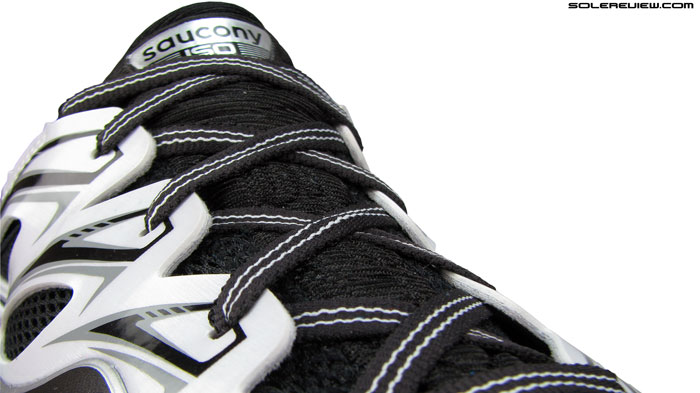
Hurricane’s eyelets have V-shaped notches separating them, but they are not as deep as Triumph’s. Here, things are a bit more closed in design.
Design of the floating synthetic cage looks very similar to the Triumph, but comes with a modified design. Simply put, the panel is more of a closed structure, not as articulated. On the Triumph ISO, the individual eyelets were punched in on straps separated by deep V shaped slits. This gave each strap liberty to act as semi-independent components, allowing to exert their own level of cinching pressure.
On the Hurricane, the cage acts as one, as the space between eyelets is filled up, lacking the gap which the Triumph panel came designed with. There are lesser number of openings cut into the side panels (in contrast to the Triumph), with the seeming intent of providing better midfoot lockdown. However, we think otherwise, and we’ll address our concerns in the fit breakout later in the review.
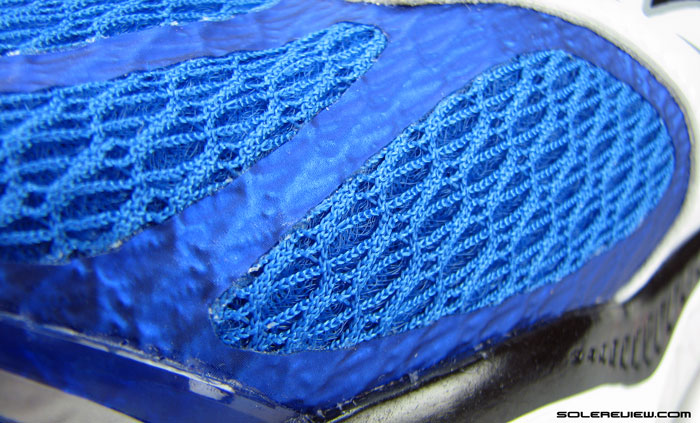
Forefoot uses hot melt layers on an air mesh. There’s more open side space than the Triumph or Guide 8.
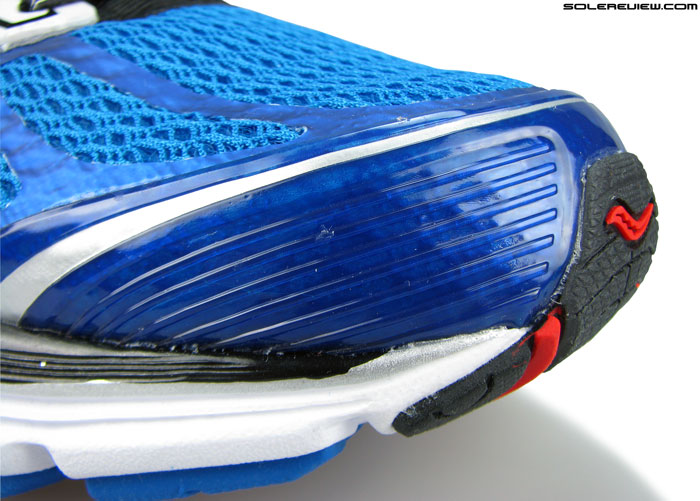
Urethane toe bumper gets the sculpted treatment too, like the heel. It’s not rigid, but collapsible.
Compared to midfoot, forefoot is an open expanse of spacer mesh, unfettered by thick overlays. A few hot melt strips run over the forefoot and on the sides.
The toe bumper is collapsible TPU in molded form, with sculpted lines and silver strips mimicking the cosmetic details of the heel counter. The mesh comes with no lining inside, so it’s fairly breathable.
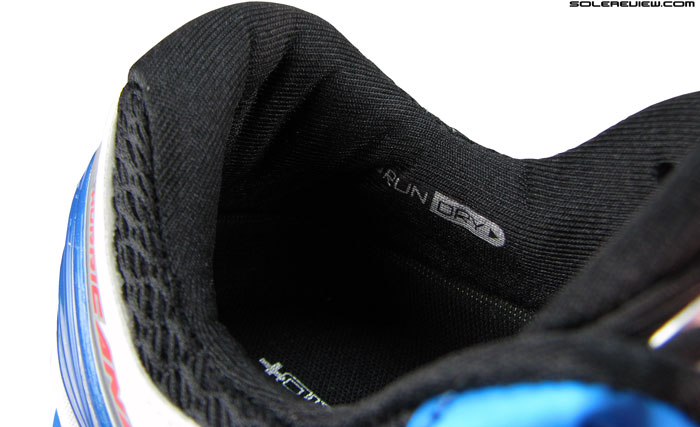
Achilles dip is very, very soft. Not much padding in the collar walls compared to the Guide and Triumph.
Fit is comparable to the Triumph ISO, but differs in a few ways. Break the similarities down, and that translates into a snug midfoot due to the floating cage, a roomy forefoot and a plushly soft collar area which feels great to slip into.
The collar area is slightly less padded than both the Triumph ISO and the Guide 8, making it very soft and suitable for runners seeking an irritation free Achilles area.
Forefoot feels freer than the Triumph ISO, despite a similar looking construction. On either sides of the forefoot, the Hurricane has more overlay-free mesh space than the Triumph. This creates greater room for foot splay, and a fit behavior which comes across as less constricted.
The lower priced Guide 8 has similar coverage of mesh combined with near identical fused overlay, but it feels way narrower than the Hurricane in stock D width.
Since the insole profiles of the Guide 8 and Hurricane are an exact match, we don’t believe there is a difference in the actual midsole profile. The reason is definitely the forefoot design; the area just in front of Guide 8’s first row lacing has a lot of material. Add to that slightly less distance between the first row of Guide 8 lacing and its toe bumper, and a stitched on toe cap.
This restricts stretching of the mesh, which the Hurricane has no problem doing so with its minimal, overlay free design in the same area.
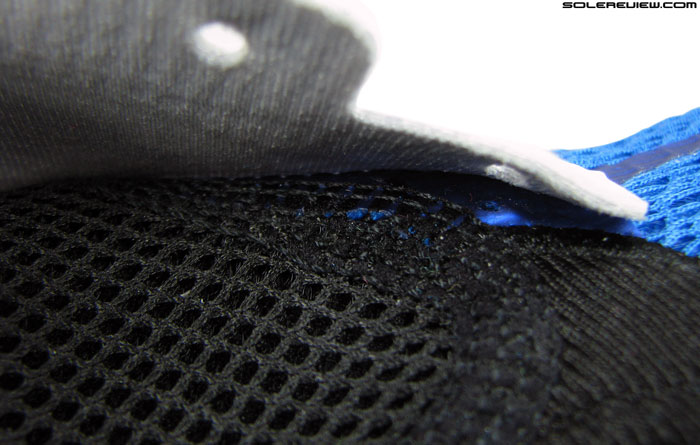
The Hurricane ISO upper has a completely sleeved construction – the air mesh is flatlock stitched to the forefoot fabric.
We called out the design difference of the floating support panel of the Hurricane vs. the Triumph earlier. While both these shoes have ISOFIT midfoot sleeve, they behave differently. We’ll explain that in a bit. First, the similarities.
The inner sleeve feels the same across Triumph and ISO; it is made of a slightly stretchable air mesh on either sides, and connects to rest of the upper by means of a zig zag seam, meaning no chafing.
Center of the tongue is mesh with molding detail which reads out ‘ISOFIT’ when seen from top, and underneath is a lining which connects to the air mesh of the sleeve. Feels very comfortable, and there’s an assuring sense of wrap. Having an internal sleeve naturally means no tongue slide, which is a minor occurrence on the Guide 8.
Where the ISOFIT really differs across both models is the quality of lockdown, and the behavior of the first lacing row near the forefoot. As mentioned previously, the synthetic panel of the Hurricane is not as articulated Triumph – less of gaps and notches. This robs each eyelet’s capability to exert an independent level of lacing pressure, and instead the whole panel works as one. If it’s not clear, we’ll try again.
Each eyelet (where the lacing goes through) of the Triumph was separated by deep grooves, so once you pull on the lacing, it resulted in the eyelets applying a custom level of pressure. Not so in the Hurricane ISO. Without the deep V shaped openings between eyelets, the whole leather panel acts as one piece. So the long and short of this is: we felt that the Triumph ISO delivered a better quality of midfoot lockdown compared to the Hurricane. The latter provides satisfactory midfoot wrap, but after tasting the Triumph’s fit, we felt it could be better.
Lastly, the forefoot. During flexing, the Hurricane panels tends to apply more pressure on the foot than Triumph. Unlike the latter, where the gaps between panel eyelets allows Hurricane’s midfoot panel tends to behave as one unit. This prevents sections of Hurricane’s floating cage to adjust their positions along with foot movement, and hence one feels more pressure on the forefoot during flexing. The design of Hurricane’s synthetic cage is such that the front is scooped in much more than the Triumph ISO, making the first two eyelets pointier. We believe this to be another reason why the Hurricane’s midfoot panel feels like the way it does.
We speak of this fit difference in relative terms; the pressure is noticeable only when you start comparing it with the Triumph. The Hurricane still fares better than the Guide 8 in this aspect, and even much better than shoes such as the 2014 Nike Free 5.0. The pressure did not translate into chafing or pain during our weariest, just an area of difference noted during change of models.
Round everything else up, and Saucony’s ISOFIT feels like a good place to make your foot home. The inner sleeve works as advertised, delivering a secure level of wrap by means of soft lining material. Forefoot, like we said before is roomy and well ventilated. Sizing fits true. D width should do it for most, leaving a small amount of buffer space right behind the toe bumper. Collar area is gradually getting standardised; the Triumph, Kinvara and Hurricane come with similar fit and feel. Soft to the touch, and keeps heel slippage in check.
A few areas we thought should be quickly pointed out. The last row of eyelet towards the heel appears to be unnecessary. If you cinch them, there’s too much pressure on the rounded corners of the tongue, and that is felt on the foot during runs. For that row of lacing to work effectively, the tongue could be made slightly longer.
The lacing is flat and semi-elastic, a type which is going around a lot these days. It does offer effective cinching, evenly distributing lacing pressure and all that, but if you cinch the first row too tight, the forefoot mesh material tends to gather/bunch up. It is not a functional drawback, but doesn’t look as good. Lastly, the Hurricane ISO’s closed design of synthetic leather panel reduces ventilation in that area, more so than the Triumph ISO and Guide 8.
Saucony Hurricane being a ‘Guidance’ shoe, comes with all the usual trappings of its kind. A firmer medial post on the arch side, tri-density midsole and all that. The lateral side profile is near identical to the Triumph ISO. A softer midsole foam spanning forefoot to midfoot, and then interlocks with a firmer SRC crashpad.
The two are separated by a plastic insert which Saucony calls the impact interface. The white area of midsole is painted in black and silver, which makes the silhouette appear lower to the ground. The midsole is topped off with a reflective overlay, a regular fixture on most Saucony models.
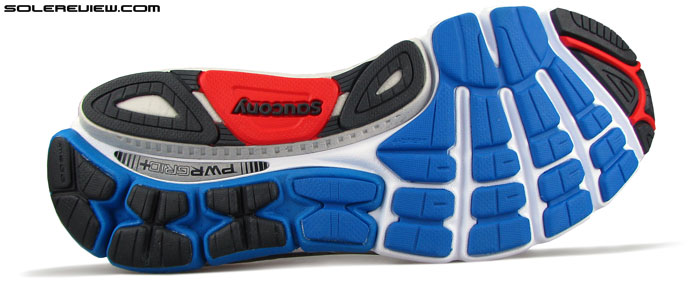
Full contact outsole. Hard XT-900 in heel and midfoot, while IBR blown rubber does traction duties upfront.
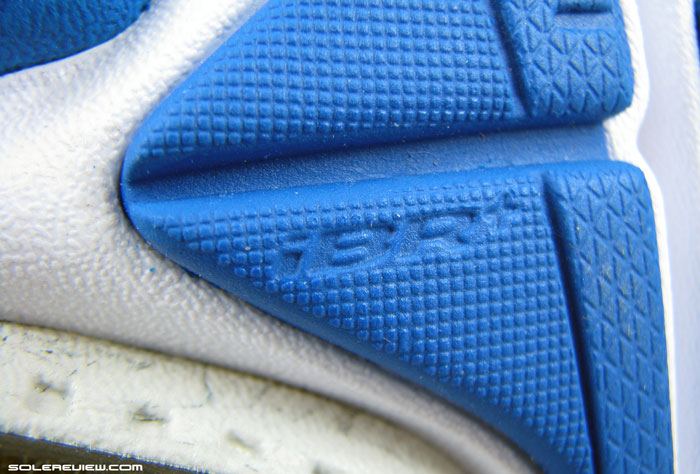
Saucony Hurricane’s forefoot. Uses softer blown rubber (IBR) against hard heel and midfoot rubber (XT-900).
The Hurricane ISO uses a full ground contact outsole, the area of rubber coverage exceeding that of the Triumph ISO and Guide 8. The portion below the medial post is completely shod with hard carbon rubber (XT-900 in Saucony speak), which wasn’t the case in the aforementioned shoes.
Forefoot is Saucony’s blown rubber (IBR). There is plenty of articulation, with deep flex grooves separating rubber pods on lateral rear to midfoot and then under the forefoot.
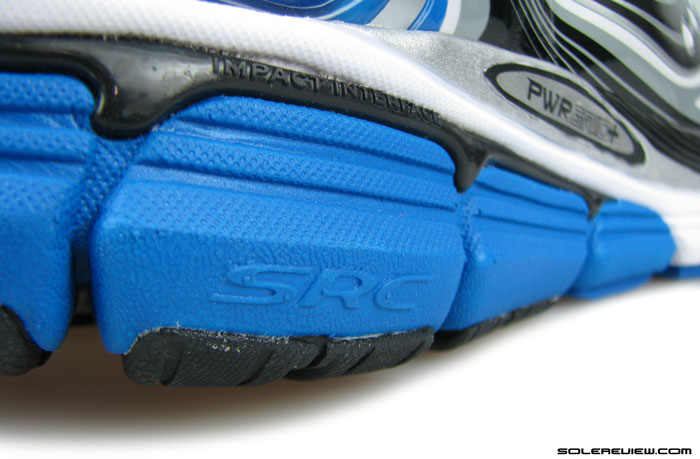
The plastic ‘Impact interface’ sandwiched between the SRC crashpad and primary midsole. Keeps things from getting mushy and helps in transitions.
This shoe rides firm, very firm. The midsole might look similar to Triumph, but the density of the SRC crash pad is higher, and remember that there is a medial post of mega proportions. It starts from the heel and extends right up to the forefoot, just below the metatarsals. The Hurricane is also a guidance or ’support’ shoe with no bias or lean in the heel area. The firm SRC crash pad+impact interface combo and the medial post sort of balance each other out, so there’s no nervous rocking movement on rear-foot strike.
And in a way, the Hurricane’s ride quality shares a common trait with the Guide 8. Which is to deliver a stable ride without the noticeable sensation of motion control, notable example of which would be models like New Balance 860 or Nike Zoom Structure 17. The Saucony Hurricane ISO feels as if it was a neutral shoe in a firmer guise. A kind of a Triumph ISO doppelgänger, only much firmer.
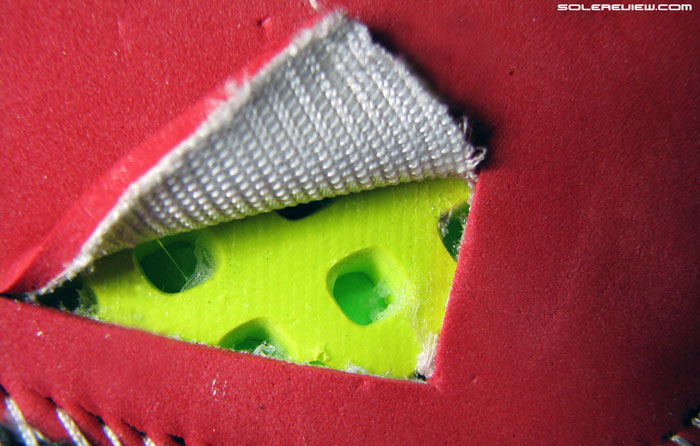
Guide 8 has a second layer of perforated foam (Powergrid) which resulted in a softer and more responsive feel than the Hurricane.
At the same time, runners transitioning from the Guide 8 might be surprised to find the latter ride softer and responsive than the Hurricane ISO. If you’ve read our Triumph ISO review, then this Deja Vu would not be lost on you. The Guide 8 and Hurricane ISO feature two different versions of the Powergrid, which results in the ride difference. The Guide 8 has an independent layer of perforated foam over the midsole (as does the Ride 7), in contrast to the Hurricane ISO’s ‘Powergrid+’, which happens to be some holes punched into the midsole. There is no separate layer here.
This leads to reduction of softness and responsiveness levels just below the removable insole. Some people might like this, some might not, but we’ve called it out so that you know the difference. Functionally, a firm midsole is by no means a lesser thing. But as far as cushioning technologies go, the new Powergrid+ is as lame as it gets.
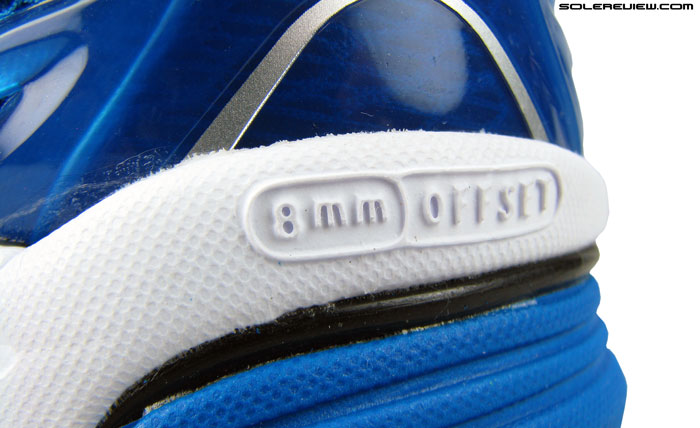
Hurricane ISO’s 8mm heel to toe drop might not vary between its dynamic (weight loaded) and static (no weight) state as the midsole is quite firm.
The Hurricane comes with a 8mm drop heel to drop, same as the Guide 8 and Triumph. The phrase ‘heel to toe drop’ is currently the running footwear industry’s most over-interpreted and over-simplified term, because it means nothing when considered in isolation. What really matters is the loaded drop, when the midsole takes on the actual bodyweight during the gait cycle, not when the shoe is sitting pretty on a shelf by itself.
In Hurricane’s case, we have no way of accurately measuring either the static or dynamic (at least not without destroying the shoe) drops. But given the firmness of Hurricane’s midsole, the static and loaded drop should not vary wildly, as the case would be in much softer shoes.
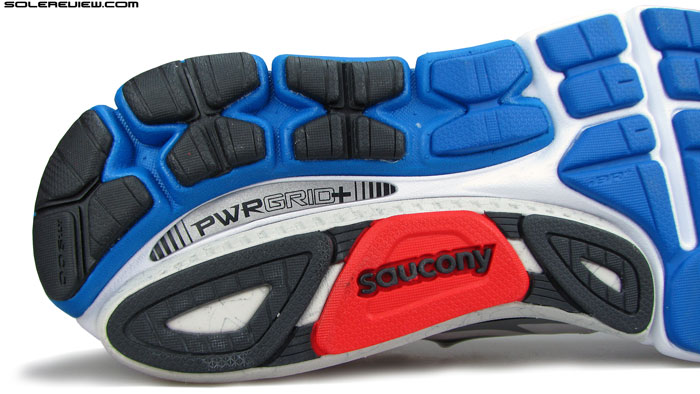
A longitudinal groove creates a chasm between medial and lateral outsole halves. Betters rearfoot midsole splay and transition. Lateral outsole has a lot of articulation, with many a flex grooves.
Transition quality proves to be pleasing on the Hurricane. The firm midsole removes any distraction, and there’s a longitudinal groove from heel to midfoot which helps the shoe track better.
Stability is great here; the heel and forefoot have a flared base, making landings planted for a variety of foot-strikes.
And we have to ask, what happened to all the reflectivity on the Hurricane ISO? Ok, there’s that strip on lateral midsole and on the outsole, but there’s hardly anything on the upper. It’s less than what’s on the Triumph, and what’s worse, than the Guide 8 too.
We paid $150 for the Hurricane, so we need our night-time bling, please.
(Disclaimer: For this review, Solereview.com bought the shoe at full US retail price.)

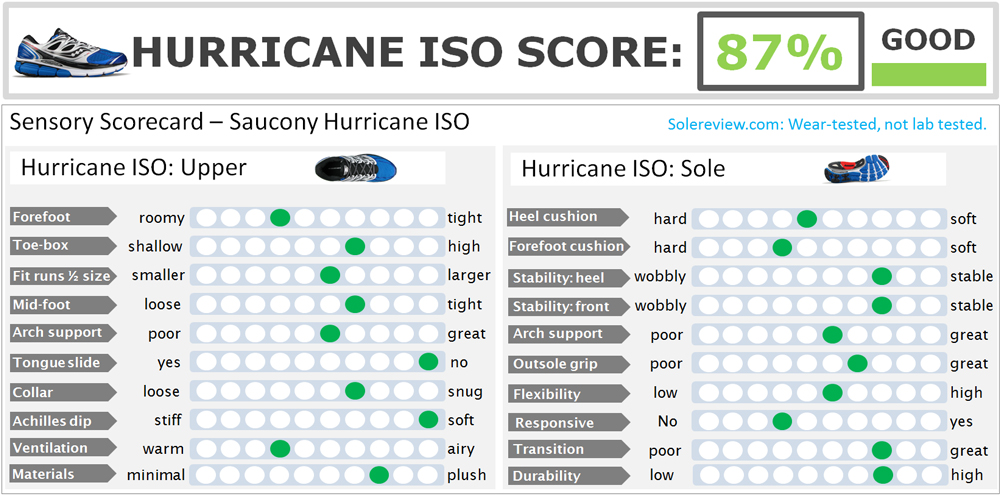
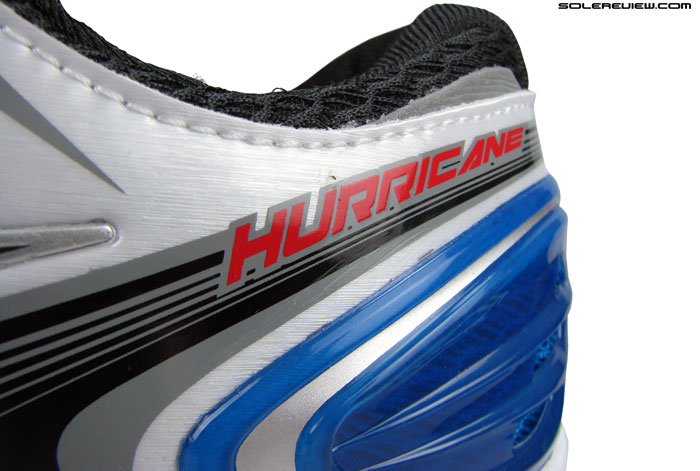
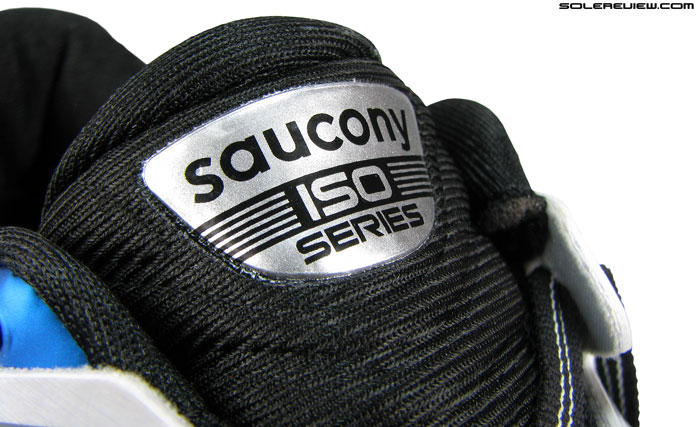
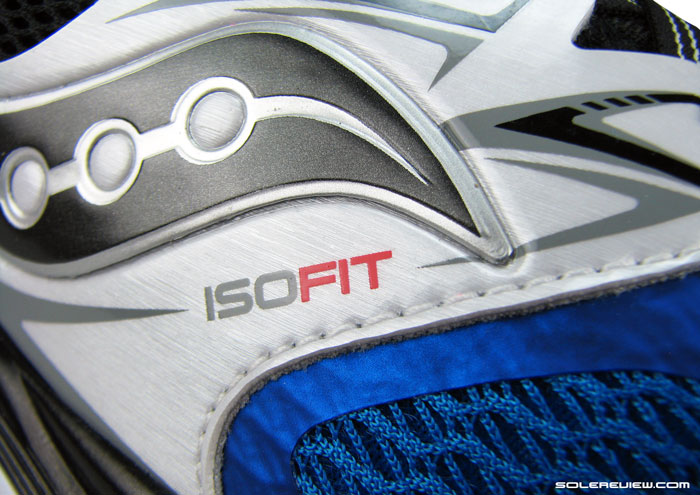
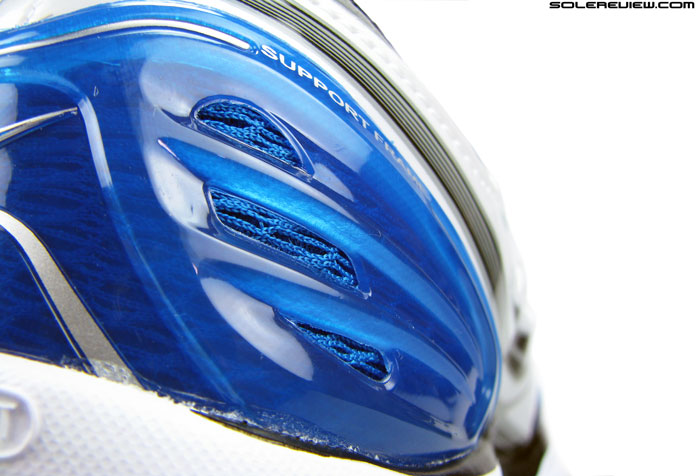
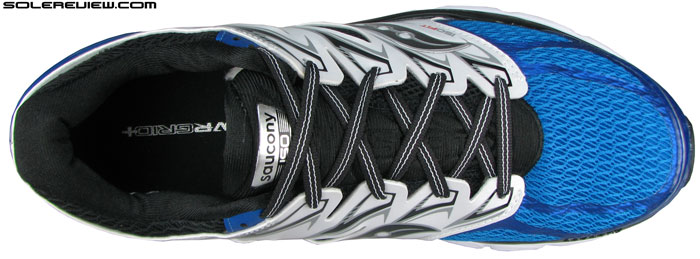
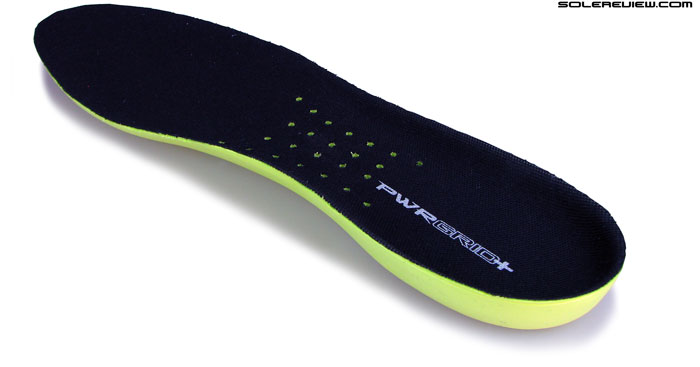
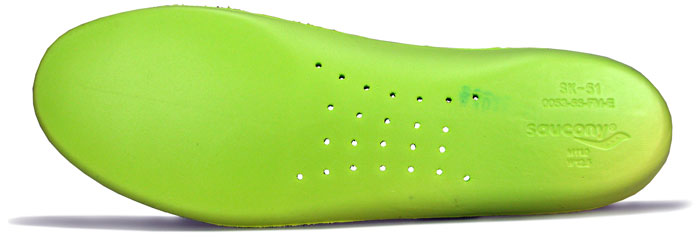
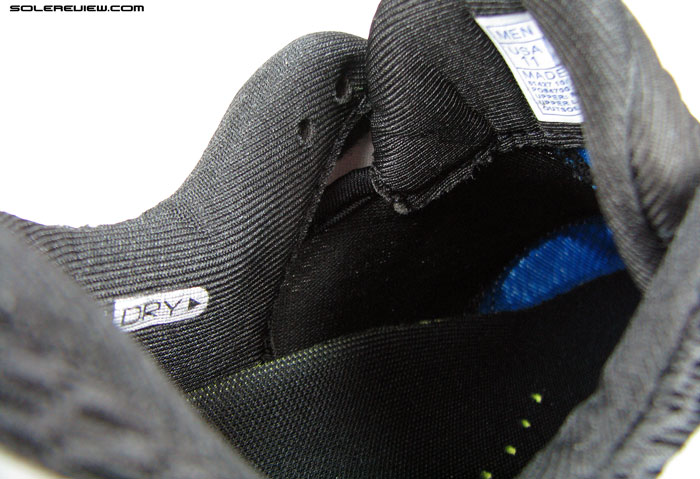
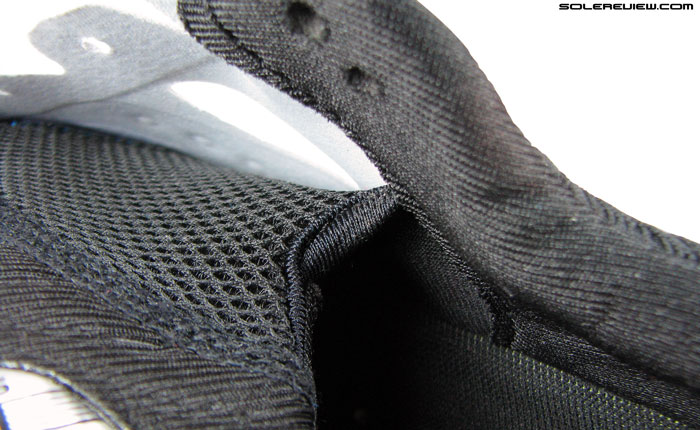
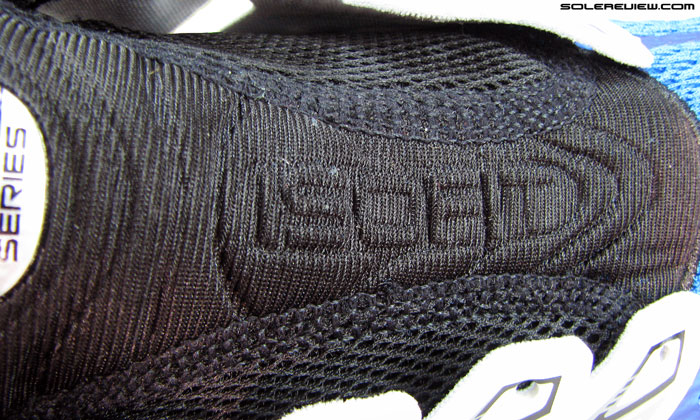
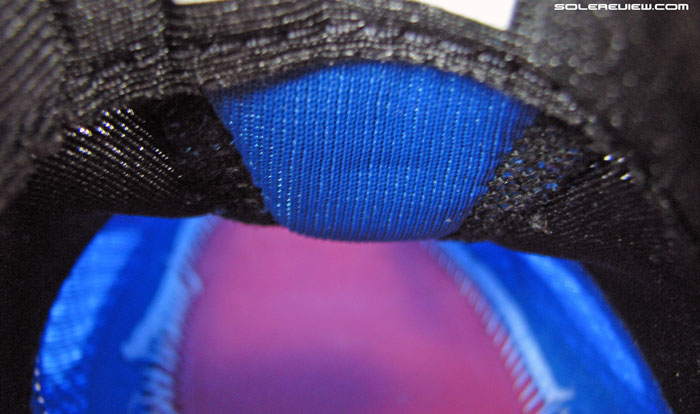
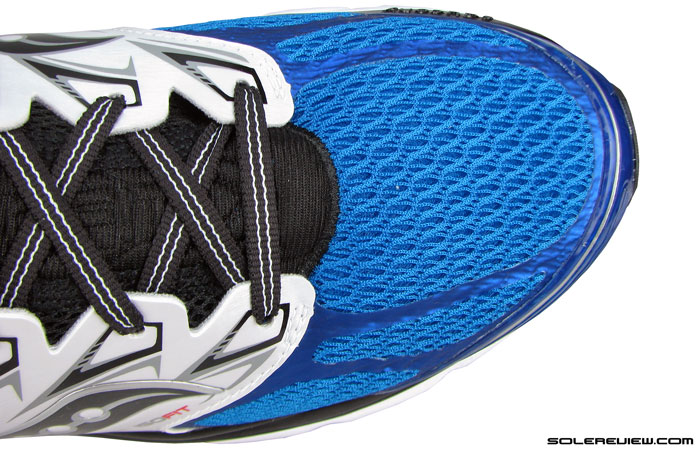
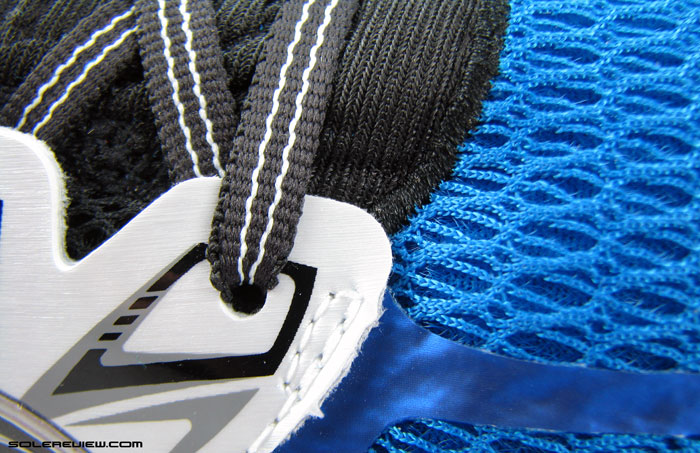
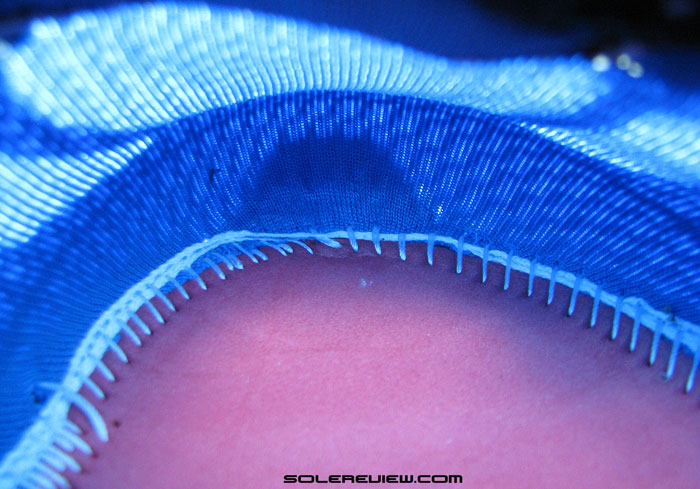
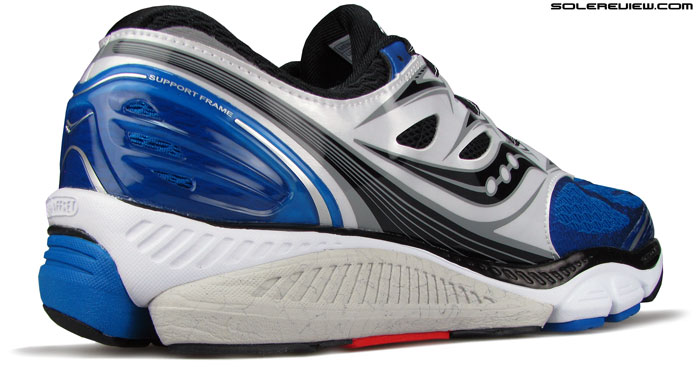
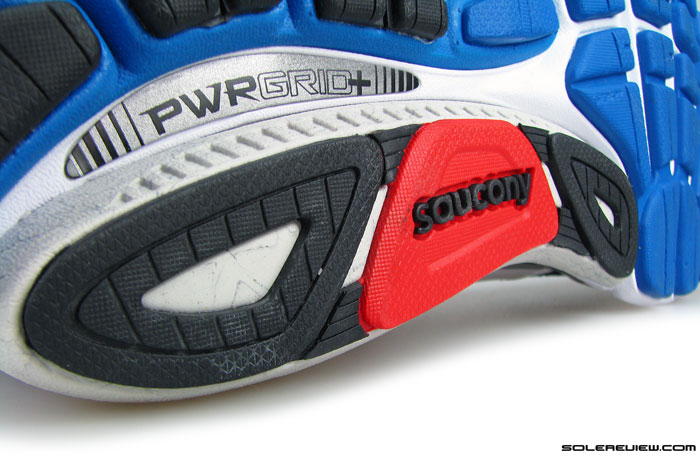
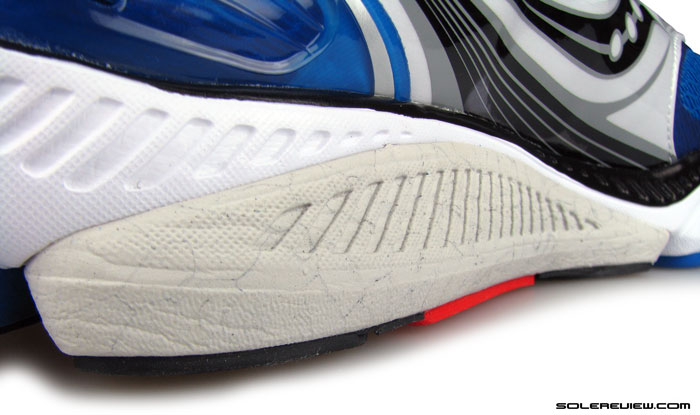
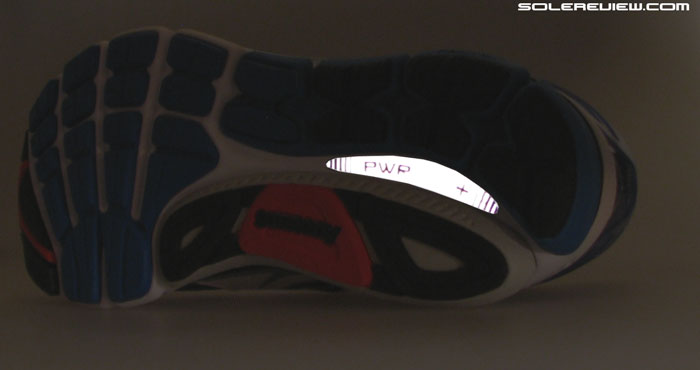
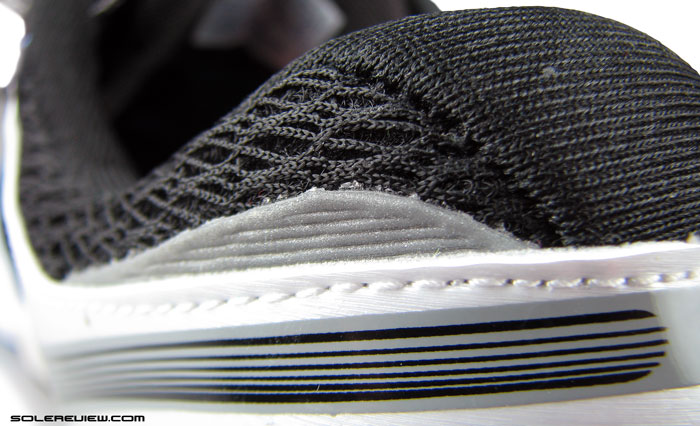
17 comments
Hi there,
Have you tried running longer distances like 10 km + in it. I thought the seam on the outer cage
was very pronounced and hard on top of close to pinky toe. It was uncomfortable running for long in them due to that. Any way to fix that ??
Yes, we went 10K+ on these. How much space do you have between the tip of your shoe and your toe?
It’s roomy there (1.5 cm), it does feel a decent fit otherwise. I just felt hard seem was rubbing too much against the foot. I might run with 2 socks on next time. I was just wondering if you noticed something similar and any suggestions on what can I do about it.
1.5 cm is pretty substantial, more than a full US size. It is possible than your foot sits more backwards in the shoe than it should, and hence you get greater feedback from Hurricane’s panel flexing.
yes I like at least 1cm room for running shoes, but I am not sure if that is the problem. Do you have any suggestion to counter that?
Our suggestion is one of the possibilities, can’t say for sure till we see it in person. Assuming the extra room was the case, then a thicker/cushioned pair of running socks can help.
Do you recommend for a mild – moderate pronator
I land on lateral heel
I normally wear stability shoes and am heavy runner
Thank you
This shoe should work, but you’ll get a better sense once you get yourself fitted at the store. What support shoes do you currently wear?
Used to wear brooks trance and old NB 990v2
After a couple of months of wearing asics gel kayano – lateral heel and foot ankle pain
Thanks. Get a fit session with the Hurricane and see how they feel.
I think you reversed the order in the paragraph when you talk about Hurricane and Triumph.
Thanks! Eight rounds of proofreads, and yet it hides in plain sight :)
Fixed.
Nice work as always on the review! So psyched about these. Got my pair in this week and looking forward to trying them out soon. Right now just trying to be patient and breaking them in around the house while nursing a calf strain. Between these and my current favorite NB 1260v4’s, I think I’ll have a nice 1-2 rotation for the year. Now I’ve just got to force myself to stay away from the 1500v1’s . . . I think I’m going to fail there.
Stay away from shoes? Good luck with that, ha ha. Every time we see a new shoe, we go: … now where’s that Amex?
Both the new ISO models disappointed me. Usually I prefer a more responsive ride but after I saw Saucony’s advertising I expected a more cushioned ride.
This is a shoe to avoid and is not the same Saucony Hurricane of the past. If you run +40 miles a week you are better running with wood planks on your feet. I have been running in the Hurricane for the past 7 years so I had no reservations in buying the Saucony Hurricane 16 ISO. Big mistake and would not recommend this shoe to anyone as it is a stiff shoe and a shoe that will give you plantar fasciitis after 200 miles. I just don’t understand why Saucony changed such a great shoe? The shoe is overpriced, insanely ugly and of course garbage cushioning. I switched to Brooks and continuing to rehab my plantar fasciitis caused by the Saucony Hurricnae ISO. I will never buy this shoe again.
Appreciate the feedback, Jon.
Comments are closed.